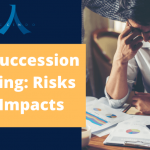
Succession planning is akin to assembling a company puzzle, crucial for seamless transitions. The blog contrasts McDonald’s successful plan with Coca-Cola’s failed attempt. Our practical guide discusses the steps on how to implement succession planning, its challenges, and engagement with senior leadership.
Introduction
Succession planning is like putting together a jigsaw puzzle for a company. Each piece represents an important job in the organisation. The idea is to find the right person for the right role, so that if someone leaves, another person can easily take over. Succession planning gives you a clear plan, enabling you to think ahead, and ensure the business continues to run during changes in leadership.
Let us explore two contrasting examples – one that showcases a well-executed succession plan, and another highlighting the pitfalls of a failed attempt.
How McDonald’s Got Their CEO Succession Planning Right
In the annals of effective leadership transition, there are instances where organisations deftly navigate the intricate process of succession planning implementation. A notable example is the smooth transition within McDonald’s, where meticulous preparation and identification of internal talent played a pivotal role.
McDonald’s, a global food service giant, faced a challenging period in 2002 with the sudden loss of two CEOs within a year. James R. Cantalupo, brought out of retirement to lead the company’s revitalisation, passed away, and his successor, Charles H. Bell, resigned due to illness.
Despite these setbacks, McDonald’s had a third CEO, James Skinner, ready to step in. The key to their success lay in a robust succession planning and management strategy initiated six years before Skinner took the helm. Cantalupo proactively groomed potential successors, with Bell benefiting from this process. When Skinner inherited the mantle unexpectedly, he continued to strengthen succession planning, fostering a corporate culture of talent development and emphasising the grooming of multiple successors for leadership roles.
This commitment to bench development enabled McDonald’s to navigate unexpected CEO exits successfully, marking a triumph in CEO succession planning.
How Coca-Cola Failed in Their CEO Succession Planning
Conversely, the corporate world is replete with cautionary tales of succession plans gone awry. A case in point is the tumultuous leadership change at Coca-Cola. Here, the lack of a comprehensive succession strategy led to internal discord and external repercussions.
Doug Ivester’s abrupt resignation after a mere two years as CEO revealed a failure in grooming him for the challenges of the role. Despite a successful tenure as CFO, Ivester proved lacking in crucial leadership skills, particularly in addressing socio-political contexts and stakeholder concerns. The mishandling of a health scare and the demotion of a key executive highlighted Ivester’s shortcomings.
The situation epitomised the pitfalls of ‘The Peter Principle,’ where individuals ascend to levels beyond their competence. The broader issues included a lack of communication between the board and corporate leadership, emphasising the need for succession planning implementation.
Coca-Cola’s reliance on a single candidate and the untimely passing of their advisor further underscored the necessity for a more comprehensive and flexible approach to succession planning.
What is Succession Planning?
The absence of succession planning can lead to various challenges when key personnel depart unexpectedly, disrupting operations, causing employee uncertainty, and negatively affecting overall business performance. Here are four reasons why succession planning is important:
- Business continuity – Succession planning ensures smooth operations during leadership transitions, minimising downtime and disruptions.
- Talent development – Succession planning motivates employees with merit-based advancement opportunities, fostering loyalty and heightened productivity.
- Addressing skill gaps – Succession planning identifies and addresses potential skill gaps in future leaders through targeted training programs.
- Strong leadership pipeline – Cultivating a pool of talented leaders through succession planning contributes to long-term organisational success and reduces reliance on external recruitment.
A well-designed succession planning framework is the backbone of any successful talent management strategy within an organisation. This structured approach ensures the identification, assessment, and development of the right individuals to fill mission-critical roles when the need arises.
Read our blog on the 5 Key Features of Succession Planning Software for Smooth Leadership Transitions to find out how the key features of succession planning function for your organisation.
Challenges Organisations Face During Succession Planning Implementation
Gaining Management and Stakeholder Buy-In
One of the primary hurdles is gaining management buy-in and cultivating trust and support among the stakeholders. For the process to be effective and successful, the entire organisational ecosystem needs to be in sync. Convincing leaders and decision-makers to implement succession planning can be a complex task, as it involves a shift from traditional practices to a more strategic and forward-thinking approach.
Resisting Bias
Resisting bias and determining the right individuals for promotion pose another significant challenge. Employees are often accustomed to established ways of doing things, and the introduction of assessments may be met with hesitation. Overcoming inherent biases and ensuring a fair and transparent selection process is crucial to the success of succession planning implementation.
Potential Loss of Control
An additional concern is the potential loss of control, especially when incumbents are involved in choosing their successors. This dynamic can lead to a lack of objectivity and may not align with the organisation’s long-term goals. Striking a balance between involvement and maintaining an impartial decision-making process is vital for the integrity of succession planning implementation.
Fear of Losing One’s Position
Fear of losing one’s position can be a pervasive challenge within organisations. Employees may resist the idea of succession planning implementation if it means that someone else may be better suited for a role they currently occupy. Addressing this fear and fostering a culture that values growth and development is essential to implement succession planning.
Existing Culture and Complacency
In some cases, there may be resistance to change embedded in the organisational culture, making it challenging to introduce new practices. Overcoming this resistance requires a concerted effort to align the values of the company with the objectives of succession planning implementation.
The Role of Technology in Facilitating Effective Succession Planning
Consistent and Efficient Data Collection
The integration of technology enables consistent and efficient data collection, including the processing and visualisation of insights derived from assessments. From gauging productivity levels to evaluating leadership capabilities, technology measures an accurate representation of data, laying the foundation for informed decision-making in the succession planning implementation.
Talent Identification for Role Fit
Automated systems enable organisations to make swift and well-informed decisions when key talents leave, ensuring a seamless transition. Moreover, technology plays a crucial role in promoting the growth and development of potential successors by providing targeted training programs and personalised development plans.
Monitoring Talent Risks
By leveraging data analytics, organisations can identify potential gaps in the succession pipeline and implement strategies to mitigate such risks. This proactive approach strengthens succession planning and management strategies, allowing for the timely identification and preparation of suitable candidates for leadership roles.
Guiding Candidates Through the Employee Life Cycle
From recruitment to retirement, digital tools assist in aligning employees with the organisation’s culture. This ensures that they acquire the necessary skills and competencies at each stage of their career. This comprehensive approach not only enhances individual performance but also contributes to the overall success of the succession planning implementation.
Accendo’s TalentPulse is an example of technology that aids in succession planning. The talent intelligence platform provides a shared data pool that facilitates the seamless transition of an employee’s information when moving from one company to another. This ensures the continuity of the employee’s professional development and allows companies to tap into a broader talent pool. Thus, enhancing the effectiveness of succession planning on an industry-wide scale.

Engaging Leadership in Succession Planning to Secure Their Buy-in
Emphasise Advantages of Succession Planning
The success and sustainability of an organisation’s leadership transition strategy depends on ensuring that senior leadership is engaged to implement succession planning. To achieve this involvement, it is necessary to emphasise the advantages of objective succession planning implementation while emphasising the risks associated with subjective planning.
Highlight the Benefits of Objectivity
Senior leaders can be made aware that the process is designed to validate their existing understanding of potential candidates. At the same time, it can also be used to reveal aspects of these individuals that may have gone unnoticed. This nuanced approach ensures a comprehensive evaluation, providing a more accurate picture of each candidate’s capabilities and potential for growth.
Establish Clear Definitions of the Plan
To align the succession plan with the organisation’s overarching goals and objectives, it is essential to establish clear definitions and a shared understanding of its purpose. In this way, succession planning contributes directly to the realisation of the organisation’s vision and mission. As a result, senior leadership becomes aware of the impact succession planning implementation has on the company’s overall success.
Involve Senior Leadership and Stakeholders
Another critical step in the planning process is involving senior leadership and various stakeholders. By doing this, you encourage a sense of involvement and ensure that diverse perspectives and experiences are considered during the process. Leaders are more likely to be committed if they believe the time dedicated to this process will yield valuable insights and contribute to long-term success.
Establish Accountability and Advocacy
Accountability and advocacy at the top will ensure that the succession planning implementation is taken seriously. Leading by example sends a powerful message to the organisation that succession planning is a priority for senior leadership. The commitment of senior leaders is further strengthened by allocating the necessary resources and treating the process with the importance it deserves.
Review and Update the Succession Plan
Reviewing and updating the succession plan regularly ensure it remains relevant and effective. This must be communicated to senior leadership, so they understand that the succession plan is a dynamic strategy that needs to evolve with the organisation’s changing landscape. Furthermore, motivating employees to participate in succession programs strengthens the succession pipeline by cultivating a pool of competent and skilled employees.
A Step-by-Step Guide on How to Implement Succession Planning

Succession planning is a valuable tool for both small and large businesses. In small businesses, this means effectively managing changes in ownership or leadership. In larger organisations, it can help to avoid potential talent gaps that can be detrimental to the company. Here, we have created a step-by-step guide to help you design a succession plan that sets your business up for long-term success.
Step 1: Crafting a Vision for Succession
Defining your goals is one part of your plan, but you also need to implement succession planning and management strategies to make sure you are on the right track. So, what does this mean? Put simply, you need to define a series of actions and strategies and craft a vision for your succession planning and management program. This vision should include:
- The goals of the program
- The key leadership positions
- The qualities and skills required of the key stakeholders.
Establish a timeline for succession, considering the long-term goals of the business:
- Where do you want to be as a business? What roles, positions, skills, and experience will you need to succeed?
- Which senior or leadership roles do you need to create a succession plan for?
- Does your business have any specific vulnerabilities that may affect your succession plan?
- Have you considered adjusting your hiring strategy to account for successor roles?
The key is to be as proactive as possible with your strategy. This initial step lays the foundation for a strategic and purposeful succession plan while anticipating the potential gaps in your workforce before they occur.
Step 2: Unveiling the Talent Pool
The next step is to evaluate your current workforce to identify key positions that may need filling in the future. Conduct a thorough assessment of your existing talent pool of employees who may be suitable replacements:
- Identifying the individuals with high potential using the 9-box grid
- Evaluating their skills, experiences, and aspirations
- Implementing succession profiles and job descriptions
Create a detailed talent inventory, mapping out the strengths and areas for improvement of potential successors. The more information you include, the easier it will be to identify the right match within your existing workforce. This stage is crucial in understanding the internal capabilities available for future leadership roles.
It is also important to be as objective as possible in this stage. You may need to consider that potential candidates may not currently be in leadership roles. After all, it is all about finding potential. And the most effective way to do this is by using succession planning tools and metrics.
Step 3: Cultural Fit – the Missing Piece of the Puzzle
Cultural fit is important when identifying potential successors. The successor should be someone who shares the values and culture of the organisation.
- Assess the cultural fit of potential successors
- Consider the values, beliefs, and behaviours that contribute to your organisational culture
To assess the cultural fit of potential successors, you can use a combination of assessments such as pre-employment assessments, personality and behavioural assessments, or culture-specific interviews. Consider the following values, beliefs, and behaviours that contribute to your organisation’s culture:
- Leadership principles
- Mission and vision
- Ways of working
- Belief systems
- Habits
- Acceptable and/or preferred behaviours
- Language and communication styles
This step ensures the chosen successors possess the necessary skills while aligning with the ethos of your organisation.
Step 4: Nurturing Future Leaders – Creative Development Paths
As soon as you have your list of potential successors and the skills they need, it is time to create a tailored development plan to help them get where they need to be. This includes:
- Training programs
- Mentoring opportunities
- Individual development plans
- Cross-functional coaching experiences
- Continuous feedback and communication
While creating a list of skills each successor currently has versus the skills they need to acquire:
- Which skills does each successor need to develop?
- What learning opportunities would help them get the right experience and expand their current skillset?
- Are there any knowledge gaps that you need to address?
Then work out the best way to offer them suitable opportunities for learning and development. By providing a variety of learning avenues, you enhance the skills and versatility of potential leaders, preparing them for the challenges of higher responsibilities.
Step 5: Fostering a Culture of Mentorship and Knowledge Sharing
A culture of mentorship and knowledge sharing stands as the linchpin in the strategic tapestry of leadership succession planning and management.
In this pivotal step, the emphasis is not only on establishing formal mentorship programs but on sculpting a bespoke ecosystem where leadership insights flow seamlessly across generations. This involves:
- Establishing formal mentorship programs where experienced leaders guide and share insights with potential successors
- Encouraging knowledge sharing across teams to ensure a smooth transfer of tacit knowledge
Here are some specific questions and considerations to address within this step:
- What are the goals of the mentorship programs and how do they align with the company’s objectives?
- How is technology leveraged to facilitate seamless knowledge transfer within succession planning?
- What KPIs are established to measure the effectiveness of mentorship programs in grooming future leaders?
- What initiatives foster collaboration and knowledge exchange between different generations of leaders?
- Are there ongoing learning opportunities focusing on succession-related skills?
This collaborative approach ensures a smooth transition of roles while forging a legacy of leadership continuity, where the wisdom of seasoned executives converges with the vitality of aspiring leaders.
Step 6: Continuous Evaluation and Measurement
It is important to continuously evaluate and measure the success of the succession planning and management program. This can involve:
- Tracking the progress of potential successors
- Monitoring the effectiveness of development programs
- Adjusting the succession planning program as needed
To measure the success of the succession planning and management program, you can use a variety of metrics such as:
- Potential
- Number of high potentials identified for each critical role
- Percentage of critical positions filled internally
- Bench strength
- Career path ratio
- Development activities
- Pipeline utilisation
This step ensures adaptability to changing organisational needs and maintains the relevance of the succession strategy. By tracking these metrics, you can gain insights into the effectiveness of your succession planning and management program and make improvements wherever necessary.
Key Takeaway
Successfully managing operations in a company relies heavily on a cohesive team contributing to various aspects. The risk of losing key members underscores the importance of having well-prepared employees capable of stepping into leadership roles during periods of growth or strategic shifts.

Implementing a succession plan is crucial in ensuring a pool of trained individuals, allowing the company to adapt to industry changes without compromising on quality. This approach provides an opportunity for established companies to invest in succession planning, aligning with technological advancement and smooth transitions into a digital future.
Accendo’s Succession Planning solution can help to digitise your succession planning process and create a more sustainable and successful succession planning. With TalentPulse, you can:
- Identify and develop your high-potential employees
- Create personalised succession plans for each key role
- Track progress and adjust when and where necessary
- Ensure that you have the right people in the right roles at the right time

Frequently Asked Questions (FAQs)
How do you implement a formal management succession plan?
To implement a formal management succession plan, start by identifying key positions, assessing current talent, and creating development programs. Ensure communication about the plan is clear, and regularly review and update it to address evolving needs.
Who is responsible for implementing a succession plan?
The responsibility for implementing a succession plan typically falls on the HR department, working closely with senior leadership. HR professionals play a key role in identifying talent, facilitating training, and overseeing the overall execution of the plan.
How to implement succession planning?
Succession planning is implemented by first identifying critical roles, assessing potential candidates, and providing targeted development opportunities. Regularly review progress and adjust the plan as needed to align with organisational goals and changes in leadership requirements.
What are the keys to implementing a successful succession plan?
The key elements for a successful succession plan include clear communication, ongoing talent assessment, tailored development programs, leadership involvement, and adaptability to changing organisational needs. Regularly evaluate the effectiveness of the plan and make necessary adjustments for optimal results.
Page Contents






